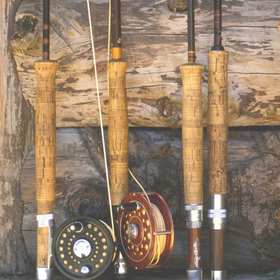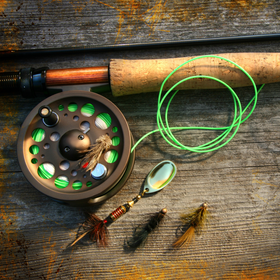This article will focus on food sources of lakes. While many of the same patterns that are used frequently in river fly fishing will also apply in lake fishing, there are some different areas of concentration for lakes.
First of all, let me state that this is intended as a general source of information. There is nothing like first hand information for the lake you are intending to fish, whether it is by observation, collection of samples, or talking with locals, direct information about your location is always the best. However, there are some generalities and some fundamental information that can be applied to lakes in general.
I keep several fly boxes dedicated to just lakes, they are filled with midges, mosquitoes, scuds, damsel and dragons, leeches, buggers, crayfish, and terrestrials.
Midges/Chironomids
Midges, also called Chironomid, are of primary importance to lake fishers. They are small worm-like in shape, and are in abundance in the majority of lake habitat. They are a reliable food source for lake trout, and can emerge every month of the year that the lake is ice free. Reliable patterns include, chironomid pupa, chironomid bomber, snow cone, pure midge, rs-2 emerger, wd-40, and for low visibility situations, the disco midge can't be beat. And for dry fly fishing try the Griffith Gnat as well as small parachute patterns like the Sprout Midge Emerger work really well.
 - Chironomid/Midge Adult. Not as important of a food source as the larva, but still a must have. (photo: www.troutnut.com)
- Chironomid/Midge Adult. Not as important of a food source as the larva, but still a must have. (photo: www.troutnut.com)
 - Chironomid Larva, the most prolific trout food in lakes. These can be brown, olive, black, cream or red. (photo: www.troutnut.com)
- Chironomid Larva, the most prolific trout food in lakes. These can be brown, olive, black, cream or red. (photo: www.troutnut.com)
Mosquitoes
Virtually every alpine lake fly fisher, knows the both the curse and blessing of the mosquito. They can both foil and save the fly fishing trip. Showing up unprepared in your fly box is bad enough, but showing up without skin protection will quickly end your trip. Mosquitoes are a hearty species indeed, hibernating all winter to show up at the earliest possible time when warming begins. They drop their resilient eggs in shallows and are valuable to fish both as larva and as adults. They can vary greatly in size so be prepared with everything form 12-16 in dries, and use chironomids for the larva.
 - Mosquito Larva. Use a Chironomid pattern for these. (photo: www.troutnut.com)
- Mosquito Larva. Use a Chironomid pattern for these. (photo: www.troutnut.com)
Scuds
Scuds are without a doubt my favorite food source for lake trout. They have high caloric content for trout, so they are readily gulped. They are a great indicator of healthy trout populations. In fact, I know of no lake that doesn't have scuds that does hold trout. I am sure they exist but they aren't the rule. Scuds are simply freshwater shrimps, they are omnivores feeding on smaller creatures and vegetation alike. They can be many different colors depending on their diet, but are most commonly gray, tan and olive. Like midges, they are constantly available and are probably more desired than midges due to their high caloric content.
 - Scuds are freshwater shrimp, and very important food sources for trout. (photo: www.troutnut.com)
- Scuds are freshwater shrimp, and very important food sources for trout. (photo: www.troutnut.com)
Dragonflies and Damselflies
Dragonflies and damselflies are commonly found in weedy areas, although they can be mud dwellers as well. Dragon and damsel nymphs have huge appetites and their constant scavenging is what makes them so available to trout. Many fly fishers that focus on lakes are students of their local dragon and damsel population. Damsel emergences are likely to happen several times a year most often in the summer. While dragon emergence happens relatively constantly throughout the summer months. Both are more valuable as nymphs than as adults. But that is not to say enticing a strike on a dry pattern is unlikely, they happen all the time. And as dry patterns they have the added bonus of easy visibility.
 - Dragonfly nymphs are a big meaty snack in the summer time. (photo: www.troutnut.com)
- Dragonfly nymphs are a big meaty snack in the summer time. (photo: www.troutnut.com)
 - Damselflies are smaller, but usually more abundant in lakes. (photo: www.troutnut.com)
- Damselflies are smaller, but usually more abundant in lakes. (photo: www.troutnut.com)
 - The 52 Buick is a great Damsel Nymph Pattern
- The 52 Buick is a great Damsel Nymph Pattern
Crayfish and Leeches
Leeches, crayfish, and forage fish are all food sources for trout. They can exist in varying availability, depending on the lake and the season, but trout will not ignore them when present. They have the added bonus of attracting larger than average trout. We were recently able to read some lake surveys done by the USFS for the Gifford Pinchot National Forest. The lakes with the big trout all had healthy crayfish populations. Lakes with small trout did not have many, if any, crayfish...
 - Crayfish are big meals for big trout. (photo: www.troutnut.com)
- Crayfish are big meals for big trout. (photo: www.troutnut.com)
Leeches tend to swim slowly and steadily. A woolly bugger, bunny leech or mohair leech trolled very slow with slow strips is a typically productive technique. Crayfish tend to move in spurts, so try a big strip with a few seconds to let it sink before the next move if you are fishing a crayfish pattern. Small forage fish can move in a variety of ways, so if you run into those, try a variety of retrieves until you find what works.
 - Leeches are common food sources in lakes. (photo: www.troutnut.com)
- Leeches are common food sources in lakes. (photo: www.troutnut.com)
 - Mohair Leech is a great leech imitation
- Mohair Leech is a great leech imitation
Terrestrials
Terrestrials are anything born on land, of most importance to lake anglers are ants, beetles and sometimes hoppers. Ant falls in particular produce great fishing. But all terrestrial fishing greatly improves with the aid of a high unpredictable wind. Concentrate on banks full of foliage where terrestrials might be lying.
Mayflies
Mayflies are not to be ignored just because your lake fishing. Again get to know your waters, but callibaetis, Tricos, and Hexagenia are all common in lakes, and their specific hatches can result in some of the hottest fishing of the year. Callibaeits tend to hatch mid day, after rains, and during cloudy days as well. They hatch over long periods of time (often all summer). The action can be crazy! They can be tan, olive, brown, or gray. Hexagenia are huge and hatch in huge numbers over a short time. One local lake here has a huge hatch that lasts about 3 days, usually right before the 4th of July.
 - Callibaetis Dun Adult. The most prolific lake Mayfly. (photo: www.troutnut.com)
- Callibaetis Dun Adult. The most prolific lake Mayfly. (photo: www.troutnut.com)
 - Hexagenia, the giant yellow mayfly. (photo: www.troutnut.com)
- Hexagenia, the giant yellow mayfly. (photo: www.troutnut.com)
Like river fly fishing, lake fly fishing requires patience and dedication to excel at it. Different, but equally as rewarding, lake fly fishing cam offer solitude that can be hard it find at popular river destinations.




